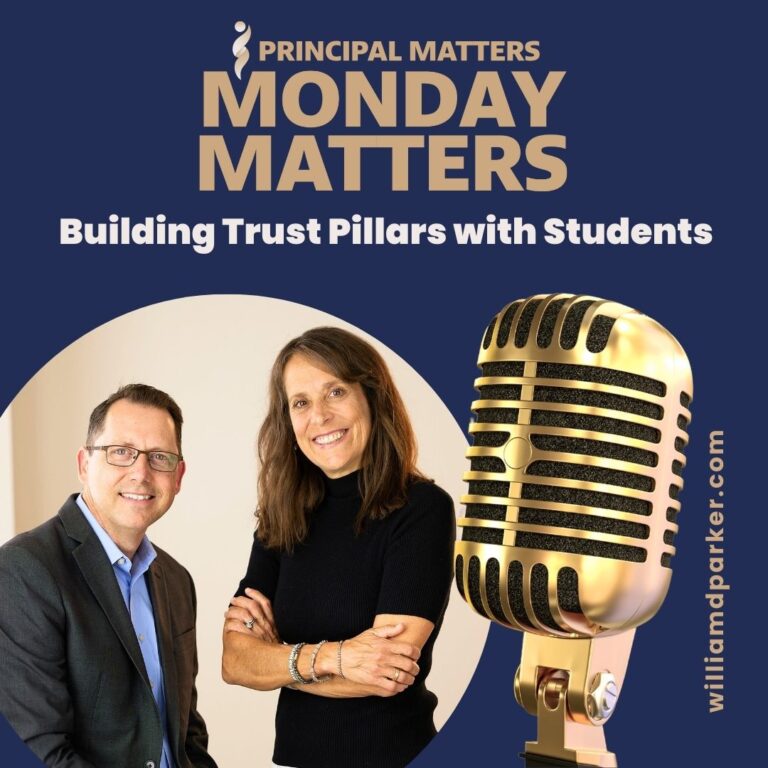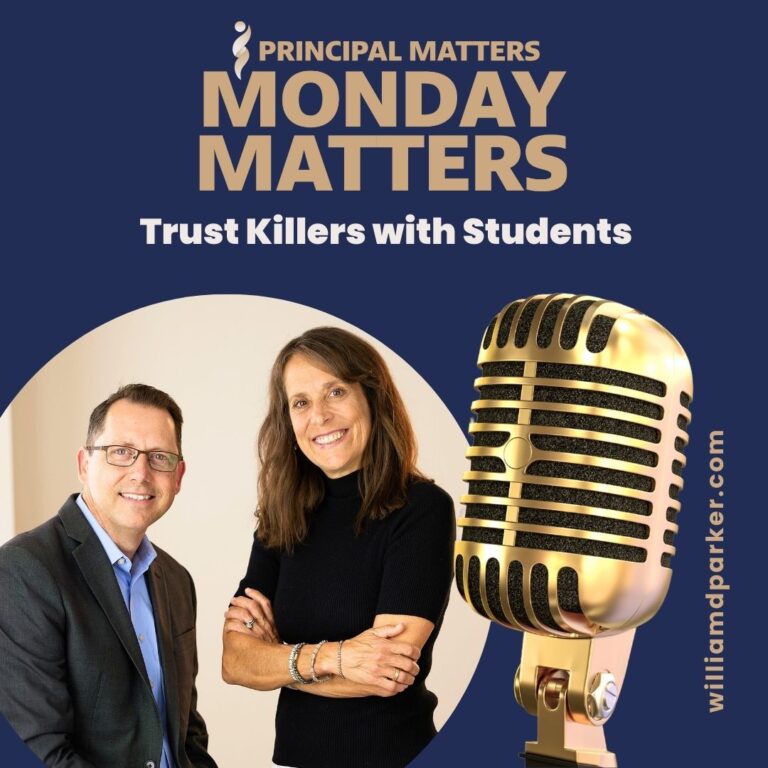Podcast: Play in new window | Download
When I was in college, I was a resident advisor in the dormitory where I lived.

My dorm director, Scott Boss, was a graduate student who not only supervised all the resident advisors in my dorm but also taught us leadership lessons. One day Scott was talking to the R.A.’s about ways we could better communicate with the other men who lived on our floors. He said something I’ll never forget. “When it comes to building relationships with others, remember this simple equation: Time Spent = Relationship Built.”
Over the years, I’ve tried to keep that in mind as I’ve visited with students, teachers, or parents. In fact, it is one of the reasons I believe parents struggle so much in connecting with their own children: they simply don’t spend enough time together. I believe the same is true for school relationships as well. The problem, however, is not always how much time you are spending with others, but the mindset you have when you are together.
These ideas were brought home to me last week when we hosted keynote speaker and author Jimmy Casas at our state principal association’s fall conference. One of the many traits I admire about Jimmy is his ability to be so direct and authentic while also encouraging and inspiring others. From his decades of experience leading schools, he challenged us think about how could move from average to excellence.
One word that Jimmy used over and over again was “relationship”. And he reminded us that no matter how many great ideas, innovative lessons, creative schedules, or talented people you have in a school—if you don’t have trusting relationships, you can’t flourish.
As I travel my state and present in other states as well, one of the toughest situations I see school leaders facing is how to affect change or build relationships in the short-term. What can a leader do right now when he or she may not have had time to build a long track record of trust?
Jimmy addressed this question too. Although long-term changes normally take long-term commitments, he pointed out that a leader can begin influencing change the moment her or she walks in a building. One way he demonstrated this was by asking us to pull out our cell phones. “Think of someone you haven’t communicated with in the past six months,” he said. “Now take a moment and text them—just saying you were thinking about them today.”
He gave us a moment to finish, and then he asked for a show of hands as people began texting back. At first a handful of hands went up, and over the next half hour, people raised their hands as they received replies.
Jimmy’s point was that each of us had just made someone’s day better. And we had just influenced our own mindset as well. We had just practiced gratitude and helped encourage one person by a quick text-message. It only took one minute. Think about the power of practicing that kind of mindset and communication throughout the small moments of school every day.
How Do You Encourage a Mindset of Excellence?
As a school leader, you naturally focus on what is urgent or broken. At the same time, if you don’t intentionally look for ways to encourage relationships, you may miss out on opportunities to build a culture of excellence. I know in my own practice as a principal, I had a decision to make every day. I could allow the troubles and challenges to be my main focus, or I could purposefully find reasons to recognize others and celebrate where they were being successful.
This doesn’t mean you ignore the facts. Yes, you must confront, protect, and instruct in areas where your school needs better service. But you can become easily overwhelmed with all the normal to-do’s of a day and forget the healthy practices of cultivating an environment excellence.
With that in mind, let me share some takeaways on how to encourage a culture of excellence:
Five practical ways to encourage cultures of excellence
1. Be in the moment.
You have a choice to make every day. When you walk into any setting, it is a choice whether you connect with others and take time to really observe what is happening around you. In school, this means modeling for teachers what you want them to be doing with students: saying hello, greeting them with a smile, finding out what they enjoy outside of school.
The other day, for instance, I was visiting a district team of administrators. I arrived a couple of hours early just so I could participate in their professional development. They spent time discussing ideas of how to face challenges in their schools and had some honest, frank, conversation and disagreements about issues facing their schools.
When it was my turn to present, I had a limited amount of time, but I was intentional in what I discussed with them because I first listened. My twenty minutes was targeted on what these leaders had just expressed they needed. Being in the moment means asking: how am I taking time to first understand before seeking to be understood?
2. Connect with peers.
How can you expect to improve if you’re not aware of where you need to grow? That is why isolation is so dangerous. We need others to talk to about ideas, push back at our assumptions, or stretch us at times.
Let me give you another example. The other night I was having dinner with two school leaders when we discussed a school crisis one of our colleagues was facing. When we asked: “What would I do if I was in charge?” Surprisingly, we came up with different answers. The back-and-forth we had then was a great way to weigh the options, think about our own responses, and decide if we needed to rethink our own positions. It also reminded that school leadership often gives you options with more than one good answer (or sometimes more than one bad one).
This point is this: Reflecting with others will stretch you to question your own assumptions and consider options you will not have thought of by yourself.
3. Help others reflect.
One of the practices Jimmy shared was how he would interview students and teachers. He would ask them questions like: What do you love about school? What makes you most excited about learning? What would you change or improve? Questions like these help you stay more deeply connected to what motivates others, and it shows others you care enough to ask.
Another idea for helping to encourage reflection is one I borrowed from my friend, Robert Schornick, Director of Secondary Instruction for Tulsa Public Schools, who also presented at our fall conference. He calls these Micro-Labs.
Here’s how Micro-Labs work: Group three peers together. Give each person 60 seconds of writing down one important takeaway from a recent lesson learned. Then each person has 90-seconds to share that takeaway with the other two while they listen attentively without interruption. I tried this and was amazed how much I learned and saw others learn from this time of shared reflection.
4. Debrief after major initiatives or wins.
Debriefing is powerful demonstration of how building relationships, reflecting on the work at hand, and sharing ideas causes you to constantly improve your processes.
This summer, Tim Elmore, the founder of Growing Leaders, in Atlanta, Georgian, invited me to present a breakout session for his national leadership conference. Because I arrived early and stayed late, I had opportunity to watch his team of twenty staff members as they hosted hundreds at their national conference.
Before the event began, Tim pulled his team together and they identified assigned responsibilities, and he reminded them of the main goal of the conference: to encourage, to inform, and to inspire other leaders. At the end of the event, Tim pulled his team together for a quick debrief. They shared success stories, reflected on lessons learned, and gave kudos to team members.
This same model works for students, teachers, or staff members.
5. Celebrate wins.
Before you move on to your next list of to-do’s, make sure you are taking time to recognize wins. For school leaders, this can happen by sharing a photo of a student who has been successful, posting a Tweet of a creative teacher, or sharing stories with your parents or community members. It also means taking time to simply tell others they have done good work or eating yummy treats together as a way to toast success.
One of my pet-peeves is when leaders say they don’t like bragging on others when they have “simply done what they should be doing anyway”. Really? If that’s the case, we should never celebrate birthdays. I mean, people turn a year older anyway, right?
Of course, we celebrate milestones because it is important for people to feel appreciated and loved. Yes, we should expect others to do what is expected, but we should also encourage a culture that acknowledges a job well done. Frankly, I would rather err on the side of celebrating small wins than allowing challenges to be the biggest news of the day. Ask teachers why they stay committed to one school for a long period of time. The more positive the culture, the longer the commitment.
Let’s Wrap This Up
One of Jimmy’s last word of advice in his presentation was to not feel overwhelmed. Choose a few areas where you want to see your school grow in excellence. Then build relationships with others toward finding solutions for those areas. After you’ve seen growth, choose a few more areas of growth for the next season. Over time, you will begin to build a momentum of culture of positivity that is contagious and difficult to stop.
Moving from a place of “average” to a place of “excellence” does not happen by chance. It happens by being in the moment, staying connected to others, helping others reflect, debriefing with others, and by celebrating together. Notice that all of these steps involve building relationships. Another word for relationship is community. And your goal as a school leaders is to build and grow excellent learning communities.
Building a culture of excellence is not easy, but it cannot happen without building relationships. And Time Spent = Relationships Built.
Now It’s Your Turn
What is one area today where you want to see positive change? How can you find just one action to move that area in the right direction? And how you can celebrate that win so others can enjoy a moment of positivity you have created for them?
Sign-Up For Free Updates and Ebook
When you enter your email address below, you will automatically receive my newest posts and a free Ebook, 8 Hats: Essential Roles for School Leaders. Let’s keep learning together!
Subscribe for free weekly updates and receive free e-book!
(function($) {window.fnames = new Array(); window.ftypes = new Array();fnames[0]=’EMAIL’;ftypes[0]=’email’;fnames[1]=’FNAME’;ftypes[1]=’text’;fnames[2]=’LNAME’;ftypes[2]=’text’;}(jQuery));var $mcj = jQuery.noConflict(true);
Principal Matters–The Book!

School leaders are very busy, so each of the twenty-four chapters is designed as a quick-read and followed with take-action questions for follow-up or reflection. If you want practical ideas on understanding your purpose, managing school teams, dealing with challenges, and leading with courage, action, motivation, and teamwork, go HERE to pick up a copy for you or your team.
Messaging Matters

Harness the power of messaging to create a culture of acknowledgment, respect, and celebration. Written specially for leaders, this title is divided into three parts, helping readers to maximize their role as chief communicators with students, teachers, and parents and community. Each chapter includes suggestions for using digital tools to enhance messaging and ends with reflection questions and practical next steps.




